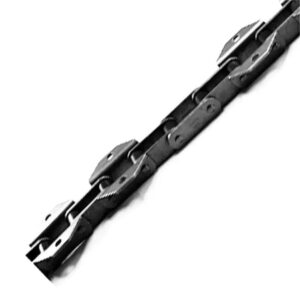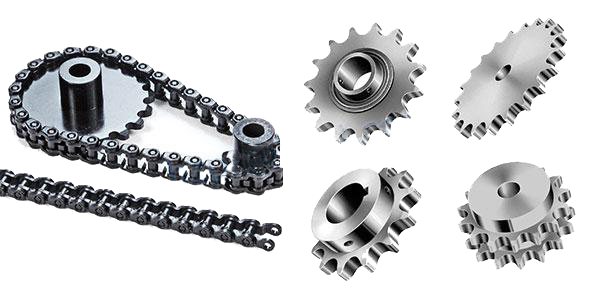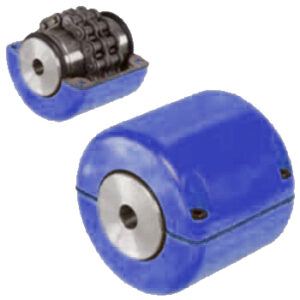Coupling Chains 4012 4014 4016 5014 5016 5018
Coupling chains are used to connect two shafts of a coupler. The chains have a continuous loop made up of master links and pins. This chain is continually in contact with the teeth on both the drive and driven chains. Proper side clearance between sprocket faces is necessary for optimal performance of chain couplers. There are many types of coupling chains. Each type is designed to handle different stresses and loads.
Coupling Chains
4012/4014/4016/5014/5016/5018/6018/6020/6022/8018/8020/8022/10018/12018/12022
Coupling chains are used to connect two shafts of a coupler. The chains have a continuous loop made up of master links and pins. This chain is continually in contact with the teeth on both the drive and driven chains. Proper side clearance between sprocket faces is necessary for optimal performance of chain couplers. There are many types of coupling chains. Each type is designed to handle different stresses and loads.
Coupling Chains Size Chart
| Chain No. | Pitch | Roller diameter | Width between inner plates | Pin diameter | Pin length | Inner plate depth | Plate thickness | Transverse pitch | Ultimate tensile strength | Average tensile strength | Weight per piece | |
| P | d1 max |
b1 min |
d2 max |
L max |
Lc max | h2 max |
T max |
Pt | Q min |
Q0 | q | |
| mm | mm | mm | mm | mm | mm | mm | mm | mm | kN/lbf | kN | kg/pc | |
| 4012 | 12.700 | 7.95 | 7.85 | 3.96 | 31.0 | 32.2 | 12.00 | 1.50 | 14.38 | 28.2/6409 | 35.9 | 0.16 |
| 4014 | 12.700 | 7.95 | 7.85 | 3.96 | 31.0 | 32.2 | 12.00 | 1.50 | 14.38 | 28.2/6409 | 35.9 | 0.19 |
| 4016 | 12.700 | 7.95 | 7.85 | 3.96 | 31.0 | 32.2 | 12.00 | 1.50 | 14.38 | 28.2/6409 | 35.9 | 0.21 |
| 5014 | 15.875 | 10.16 | 9.40 | 5.08 | 38.9 | 40.4 | 15.09 | 2.03 | 18.11 | 44.4/10091 | 58.1 | 0.49 |
| 5016 | 15.875 | 10.16 | 9.40 | 5.08 | 38.9 | 40.4 | 15.09 | 2.03 | 18.11 | 44.4/10091 | 58.1 | 0.56 |
| 5018 | 15.875 | 10.16 | 9.40 | 5.08 | 38.9 | 40.4 | 15.09 | 2.03 | 18.11 | 44.4/10091 | 58.1 | 0.63 |
| 6018 | 19.050 | 11.91 | 12.57 | 5.94 | 48.8 | 50.5 | 18.00 | 2.42 | 22.78 | 63.6/14455 | 82.1 | 1.00 |
| 6020 | 19.050 | 11.91 | 12.57 | 5.94 | 48.8 | 50.5 | 18.00 | 2.42 | 22.78 | 63.6/14455 | 82.1 | 1.11 |
| 6022 | 19.050 | 11.91 | 12.57 | 5.94 | 48.8 | 50.5 | 18.00 | 2.42 | 22.78 | 63.6/14455 | 82.1 | 1.22 |
| 8018 | 25.400 | 15.88 | 15.75 | 7.92 | 62.7 | 64.3 | 24.00 | 3.25 | 29.29 | 113.4/25773 | 141.8 | 2.35 |
| 8020 | 25.400 | 15.88 | 15.75 | 7.92 | 62.7 | 64.3 | 24.00 | 3.25 | 29.29 | 113.4/25773 | 141.8 | 2.62 |
| 8022 | 25.400 | 15.88 | 15.75 | 7.92 | 62.7 | 64.3 | 24.00 | 3.25 | 29.29 | 113.4/25773 | 141.8 | 2.88 |
| 10018 | 31.750 | 19.05 | 18.90 | 9.53 | 76.4 | 80.5 | 30.00 | 4.00 | 35.76 | 177.0/40227 | 219.4 | 4.95 |
| 10022 | 31.750 | 19.05 | 18.90 | 9.53 | 76.4 | 80.5 | 30.00 | 4.00 | 35.76 | 177.0/40227 | 219.4 | 4.95 |
| 12018 | 38.100 | 22.23 | 25.22 | 11.10 | 95.8 | 99.7 | 35.70 | 4.80 | 45.44 | 254.0/57727 | 314.9 | 8.14 |
| 12022 | 38.100 | 22.23 | 25.22 | 11.10 | 95.8 | 99.7 | 35.70 | 4.80 | 45.44 | 254.0/57727 | 314.9 | 8.14 |
What Are Coupling Chains?
Coupling chains are an essential part of rotating equipment. They help move large loads, which is useful for mining, farming, and metal manufacturing applications. While the most common kind of chain is the roller chain, coupling chains can extend the life of the roller chain by increasing its tensile strength and weight capacity.
The chain couplings consist of a pair of identical sprockets connected by duplex roller chains. Plastic chains can also be used, but they require no lubrication and do not have covers. Coupling chains are generally installed off the end of a motor or reducer, where they connect with the machine. A complete coupling consists of two hubs and one coupling chain. A chain coupling can works with a variety of applications, depending on the conditions it must operate in. For example, a coupling chain can be made from acetal plastic, which is resistant to grease.
Because coupling chains are relatively low-maintenance and easy to install or remove, they offer an excellent cost-performance ratio. Coupling chains are usually available in various sizes. They are usually mounted on opposite shaft extensions. They must meet specific requirements to be effective, and the chain must maintain a minimum clearance between the two sprockets. Coupling chains are also easy to install and remove, and the single connecting pin makes them quick and easy to use.
How to Use a Coupling Chain Properly?
A coupling chain is a mechanical fastener that connects two parts. It can be used for a variety of applications, including farming, mining, and metal manufacturing. It’s also used to extend the usable life of roller chains. Roller chains are the most common type of chain used today, but coupling chains have a higher strength and can withstand more stress. Whether you’re using a chain for agricultural applications or industrial applications, it’s important to know how to use one properly.
Coupling chains are continuous loops of pins and master links worn over and around the drive and driven chain wheels. As they are constantly in contact with the chain teeth on both wheels, they prevent the couplers from misaligning. Coupling chains can compensate for two degrees of misalignment, making them ideal for high-torque and low-speed environments. To maintain proper performance, use a chain coupler that has sufficient side clearance between the sprocket faces.
Coupling chains are a simple mechanism that ensures all machine parts are functioning properly. They are easy to install, replace, and remove. They are a simple, straightforward way to keep your machine running smoothly. Coupling chains can also prevent inconsistencies in performance because they spread torque evenly across the chain. A good coupling chain will ensure that there is no lag time. And since coupling chains are a simple device, they are easy to use and install.
Chains and Sprockets
Chains and sprockets are mechanical devices that allow two shafts to rotate in synchronization. These two components are making of steel, nylon, or Teflon. There are a few common types of chains and sprockets. The material of these components determines their use and how long they should last.
Whether you need a chain for a bicycle or a sprocket for a conveyor, a chain sprocket is your answer. Chains are widespread and have a long history of use. They have a wide range of uses, from industrial applications to recreation. A bicycle chain is a common part of many other mechanical devices. Depending on the application, there are different types of chains.
For a general guide to choosing a chain, check your manual for a chain size chart. There are commonly listing chain sizes as well as sprockets, which are according to ANSI standard. The first digit of a chain’s pitch measures the distance between the rivets. For example, a “5” chain has a pitch of five eighths of an inch. A sprocket with a “20” code is a sprocket with two strands running parallel to each other.
Our company is one of the leading mechanical transmission parts manufacturers and suppliers who can offer a wide range of drive chains and sprockets for sale. Contact us!

Packing Shipping Delivery
  |
 |
|
 |
 |
|
How to choose power transmissions parts and industrial products which meet our requirement
| Chains | Sprockets | Pulleys | Timing belt Pulley | V-belt Pulley |
| Sheaves | Coupings | Bush &Hub | Gear& Rack | V-Belt |
| Locking Assembly | Pulley | Gearbox | Reducer | Shaft Collar |
| Rod End Bearing | Clevis | PTO | Chain Guide | Belt Guide |
| Rubber Buffer | Chain Tensioner | PTO Drive Shafts | Universal Joints | Roller Chains |
| Conveyor Chains | V-Belts | Worm Gearbox | Helical Gear | Worm |
| Agricultural Chain | CNC Proces Parts | Casting | Stamping | |
| Powder Metallurgy | CNC Proces Parts | Casting | Stamping |
What Products Do you sell ?
We are a group of factories, give customer one stop solution of power transmission and industrial products. We are in the position to supply wide range of products, including chains, sprockets, v-belt and v-belt pulleys, timing belt and timing belt pulleys, gears, speed reducers, motors, racks, couplings, and many other parts, like locking assembly, taper bushing, Chain guide, shaft collar, torque limiter, cam clutch, universal joint, motor base and motor slide, rod end, clevis, rubber mount, etc. We make special parts according to drawings and/or samples.
How to choose a gearbox which meets our requirement?
You can refer to our catalogue to choose the gearbox or we can help to choose when you provide
the technical information of required output torque, output speed and motor parameter etc.
What information shall we give before placing a purchase order?
a) Type of the gearbox, ratio, input and output type, input flange, mounting position, and motor informationetc.
b) Housing color.
c) Purchase quantity.
d) Other special requirements.
What industries are your gearboxes being used?
Our gearboxes are widely used in the areas of textile, food processing, beverage, chemical industry,
escalator,automatic storage equipment, metallurgy, tabacco, environmental protection, logistics and etc.
What is the producing process?
Production process including raw material cutting, machine processing, grinding, accessories cleaning, assemble, cleaning, stoving, oil coating, cover pressing, testing, package.
How to control the products quality?
Combining advanced equipment and strict management, we provide high standard and quality bearings for our customers all over the world.
What is the transportation?
-If small quantity , we Suggest to send by express, such as DHL,UPS, TNT FEDEX. If large amount, by air or sea shipping.
Can we design packaging?
-Yes. Default is regular packing, and we can make customer's own packing.
Can you provide OEM service?
-Yes, we work on OEM orders. Which means size, quantity, design, packing solution, etc will depend on your requests; and your logo will be customized on our products.
Can you give me discount on Power Transmissions Parts and Industrial parts?
-Yes, of course. Pls. send me your Email, you'll get more
Q: Are You a trading company or a manufacturer?
A: We Are the factory and have our Own trading company
Q: How Can I get an offer?
A: please send US quotation information: drawings, materials, weight, quantity and requirements, we can accept PDF, ISGS, DWG, STEP file format. If you don't have the drawings, please send us the samples, we can also quote you according to your samples.
Q: What is your minimum order size?
A: it is usually 100 pieces, but a low quantity is acceptable under some special circumstances.
Q: Do you provide samples? Is it free or extra?
A: Yes, we can provide samples free of charge, but we don't pay the freight.
Q: What is the lead time for mass production?
A: honestly, it depends on the number of orders. Normally, if you don't need the tools, deposit them after 30 days or so.
Q: What if the parts don't Work?
A: we can guarantee the quality, but if it happens, please contact us immediately, take some photos, we will check the problem and solve it as soon as possible.
Q: What are your terms of payment?
A: payment is less than US $1000,100% in advance. Payment: $1000,50% wire transfer in advance, balance before shipment,Other Terms of payment are negotiable






Reviews
There are no reviews yet.